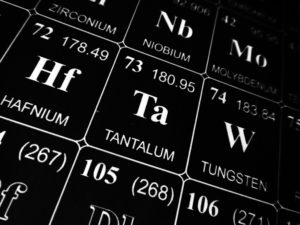
Responsible sourcing is the human-rights aspect of supply chains. The idea is that it’s not enough to follow ethical practices within your own business. You also need to ensure that your raw materials are not products of exploited labor, unsafe working conditions, environmental destruction, or other unethical practices. But how do you identify such materials? Drive Sustainability, the Responsible Minerals Initiative, and The Dragonfly Initiative have produced a report, Material Change, that gathers the information into one place. It examines both the human-rights and environmental implications of material supply chains. As we’ll see, the two may be closely related.
To comply with the Dodd Frank Act of 2010, corporations must report the provenance of the materials they use. Dodd Frank designates gold, tantalum, tin, and tungsten as “conflict minerals.” That is, the proceeds from these metals may be fueling regional conflicts. Companies on United States stock exchanges must report their use of these minerals from Congo and neighboring countries.
Beyond conflict minerals
Material Change addresses other materials besides conflict minerals—a total of 37 in all. It examines the components of electronic products such as smart phones to show which materials are in which parts. For example, the battery might contain cobalt, graphite, lithium, and nickel. We’ve discussed cobalt in a previous blog, so let’s look at lithium.
Most of the world’s lithium comes from the “Lithium Triangle”—Argentina, Bolivia, and Chile. Argentina has weak rule of law and widespread corruption. Indigenous peoples claim that lithium mining there has reduced both the availability and quality of water. In addition, there’s no formal process for negotiations between indigenous peoples and the mining companies.
Bolivia has only begun to exploit its lithium reserves. Already, though, environmental damage from lithium mining has resulted in conflicts with indigenous peoples. With very weak rule of law and widespread corruption, Bolivia is ill-equipped to resolve these problems. Indeed, the situation is likely to deteriorate with increasing worldwide demand for lithium.
Even in Chile, with its strong rule of law and little corruption, lithium mining negatively affects flamingos. Five lakes in the Chilean Andes are home to three species of flamingo, two of which breed nowhere else. Climate change has shrunk these lakes, but the flamingo population is declining only near the lithium mines. As the basis of the local ecotourism industry, flamingos are important economically.
For all three countries, the depletion and contamination of scarce water resources has the potential to increase conflicts with indigenous peoples.
Material Change promotes health, safety, and welfare
We often think of solar- and wind energy as green because they don’t emit CO2 the way fossil fuels do. And they’re renewable to boot. However, they’re not completely benign. Intermittent energy sources require batteries to store energy so it’s available when needed. The lithium and the even more problematic cobalt need to come from somewhere.
The engineers’ code of ethics states that engineers shall “hold paramount the safety, health, and welfare of the public.” To this end, a good engineering education requires that students be able to analyze the implications of their work. Material Change is one resource I recommend to my students as a good starting point. It doesn’t have all the answers, but it helps the students ask the right questions about supply chains.
